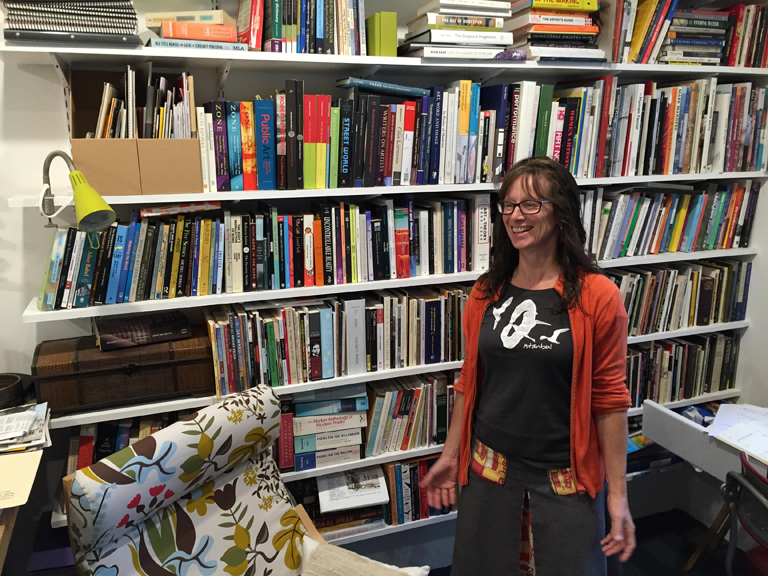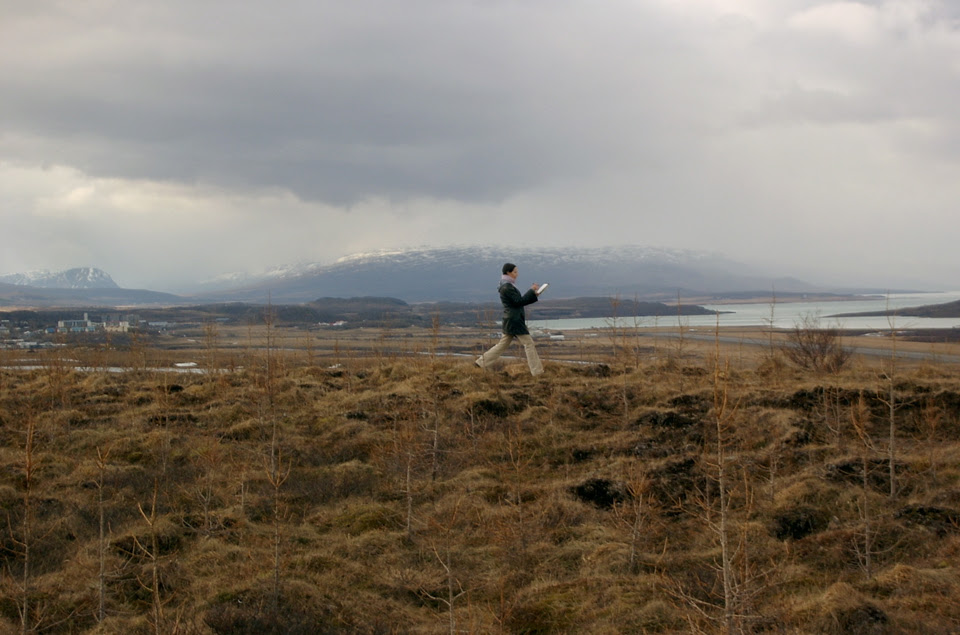by Jenna Crowder
[Drawing is] “A dot taken for a walk.”
— Angela Ellsworth
During her lecture at the Institute for Contemporary Art at Maine College of Art, Angela Ellsworth described the practice of drawing as “a dot taken for a walk.”1 Ellsworth, the Co-Founder and Director of the Museum of Walking in Tempe, Arizona, went on to define walking as not only bodies moving in space, but “bodies in conversation with the landscape and with each other”, making visible the lines and relationships that connect walking to drawing and aesthetics, participatory art, history, and place.
It is with a distinct sense of pedagogy that Julie Poitras Santos has created PLATFORM PROJECTS/WALKS, a two-week-long project for which Ellsworth’s Tuesday evening lecture served as a kind of ceremonious opening. PLATFORM PROJECTS/WALKS positions Poitras Santos as artist-as-curator, who has included fifteen artists and practitioners who’ll be leading walks, giving lectures, discussing readings, and presenting video works — another distinctively time-based medium — through August 14.
I visited Poitras Santos’ Munjoy Hill studio to discuss PLATFORM PROJECTS/WALKS, a project funded by the Kindling Fund through SPACE Gallery, from its historical roots to its feminist implications and the act of walking as an aesthetic act.
Julie Poitras Santos lights up when talking about the relationship between walking and writing. She speaks animatedly about the rhythm of walking, which can change in accordance to gait, to mood, to surface, to weather. She conjures Wordsworth and jumps up to float across her studio floor, emphasizing syllabic weight with her right foot as she recites:
“I wandered lonely as a cloud”
It’s easy to feel Wordsworth’s steps throughout the poem. Written in iambic tetrameter, his rhythm takes the reader, mentally, on the same walk through daffodils, beside the lake and beneath the trees2. Poitras Santos notes that walking is often important to writers and artists, as a “way to bring creative ideas into being, that with breathing and running, it can act as a meditative state of provocation.”
Poitras Santos is both a visual artist and a poet, holding an MFA in Visual Arts from the University of Colorado at Boulder as well as an MFA in Poetry from the Stonecoast Creative Writing program, so it makes sense that her work often incorporates the “horizontals”, as she calls them, lines of translation, between writing and art, between people and relationships, and throughout history. On the PLATFORM PROJECTS/WALKS website, she enumerates several literary examples of historical walking including Wordsworth, Rousseau, and Charles Baudelaire, who, in the 1860s gave us “the notion of the flâneur, the artist-poet wanderer of urban spaces.”3 Philosopher and critic Walter Benjamin brought Baudelaire’s imagery of the “passionate spectator”4 into academia, providing historical context for PLATFORM PROJECTS/WALKS and paralleling Poitras Santos’ own artistic practices that encompass a spectrum of installation, performance, writing, and teaching. Poitras Santos goes on to trace walking in the visual arts:
“André Breton and Tristan Tzara, created their Excursions & Visites Dada in the 1920s. In the 1950s, Guy Debord and the Situationist International, developed the dérive of psychogeography, a method of unplanned wandering to discover the qualities of place and encounter new experience. Fluxus artist Stanley Brouwn is known for his records of walking, and the 1960s and 70s also brought such artists as Richard Long and Hamish Fulton to the attention of the art world. Other artists who create walks include Janet Cardiff, Ernesto Pujol and Francis Alÿs.”
With the exception of Cardiff, the list consists entirely of men. Poitras Santos isn’t shy about acknowledging that walking has very much been a history primarily written by men, explaining that women have traditionally felt less safe in the practice of walking across all its iterations. “It relates back to the idea of the isolated artist in the studio as well as the isolated artist or person in the landscape: this is typically the realm of men,” she says. “For women walkers, we often see women in groups rather than alone.”

Poitras Santos herself has spent years walking around the world. When she was 22, she walked through India and Morocco alone. “Perhaps I was naive about that,” she reflects. “Walking is a practice and activity that is available to women, but there is also a need for awareness and to recognize these inequalities.” Lauren Elkin, for The Guardian, describes the flâneur in her timely essay, “A tribute to female flâneurs: the women who reclaimed our city streets”:
“He is also, always, a man. It’s strange: for as long as there have been cities, there have been women living in them, yet if we want to know what it’s like to walk thoughtfully in the city, there is only a long tradition of writing by men that tells us, stretching from Thomas De Quincey to André Breton to Will Self. But if we want to know how women experience the city?”5
In 2006, Poitras Santos was at a residency in France working on a walking project related to the Camino de Santiago. While there, she read Rebecca Solnit’s Wanderlust which changed the way Poitras Santos thought about her work. Walking became a way for her to be a voice represented among a chorus of other women’s voices. Further adding to this chorus in PLATFORM PROJECTS/WALKS, Poitras Santos invited several women to participate: in fact, thirteen of the fifteen artists included are women, and while not all of them regularly employ walking explicitly in or as their artistic practices, here all are investigating walking through an aesthetic lens. Elkin again:
“Perhaps the answer is not to attempt to make a woman fit a masculine concept, but to redefine the concept itself. It’s time to recognise a counter-tradition of the flâneuse, looking back to George Sand, to Jean Rhys, or in our own day to Sophie Calle, or Laura Oldfield Ford. If we tunnel back, we find there always was a flâneuse passing Baudelaire in the street.”6
Poitras Santos didn’t start out to answer the problem of a lack of representation of women and walking. (Though these days she is certainly thinking on that pedagogically and in practice.) Poitras Santos is interested in walking as it is related to ritual, translation, and transposition of space, and naturally how it extends to performance and performed identity. With the performative aspects of walking, she considers boundaries and, when there is an audience, their location: for example, acts of participatory walking ask the audience to engage in ways that are fundamentally intimate and risky (as perhaps most participation is), but walking can be a low-risk means to engagement.
Poitras Santos recently attended a month-long residency at Brunakra in Sweden, where she was working on a project entitled Map & Universe. The project included a walk in a labyrinth in a courtyard as part of an evening of walking, story telling, and community dinner. Participants told various stories: some prepared ahead of time, some on a whim. Poitras Santos describes one woman that evening who noted that her participation — through telling a story — felt risky as an audience member, but noted that the artist is always risking, always made vulnerable by virtue of making and presenting the work, and perhaps by participating, the audience could actually become part of the work rather than stay in the role of “external judger”.
Over the next two weeks, Poitras Santos and fifteen other artists will invite audiences to become part of the work of PLATFORM PROJECTS/WALKS through acts of walking, viewing, reading, and discussing, spanning a broad range of intimacy and engagement for the audience. But participation and aesthetics do not stand alone here. As participants, we are also actively writing the history of a chorus of voices in this place and time: our engagement defines, perhaps, a new kind of pedagogy in which we now recognize that there is always a flâneuse passing us in the street. 7
PLATFORM PROJECTS/WALKS runs through August 14, 2016 throughout Portland, Maine.
Events for PLATFORM PROJECTS/WALKS are happening everyday (sometimes twice a day) through August 14. The full schedule of events can be found here.
For more information about Julie Poitras Santos’ work, visit her website.
- After Paul Klee’s description of drawing as “taking a line for a walk”. ↩
- William Wordsworth, “I Wandered Lonely as a Cloud”, https://www.poetryfoundation.org/poems-and-poets/poems/detail/45521 ↩
- http://www.platformprojectswalks.com/what-we-do/ ↩
- “The crowd is his element, as the air is that of birds and water of fishes. His passion and his profession are to become one flesh with the crowd. For the perfect flâneur, for the passionate spectator, it is an immense joy to set up house in the heart of the multitude, amid the ebb and flow of movement, in the midst of the fugitive and the infinite. To be away from home and yet to feel oneself everywhere at home; to see the world, to be at the centre of the world, and yet to remain hidden from the world—impartial natures which the tongue can but clumsily define. The spectator is a prince who everywhere rejoices in his incognito. The lover of life makes the whole world his family, just like the lover of the fair sex who builds up his family from all the beautiful women that he has ever found, or that are or are not—to be found; or the lover of pictures who lives in a magical society of dreams painted on canvas. Thus the lover of universal life enters into the crowd as though it were an immense reservoir of electrical energy. Or we might liken him to a mirror as vast as the crowd itself; or to a kaleidoscope gifted with consciousness, responding to each one of its movements and reproducing the multiplicity of life and the flickering grace of all the elements of life.” — Charles Baudelaire, “The Painter of Modern Life”, (New York: Da Capo Press, 1964). Orig. published in Le Figaro, in 1863. ↩
- Lauren Elkin,”A tribute to female flâneurs: the women who reclaimed our city streets”. The Guardian, July 29, 2016. https://www.theguardian.com/cities/2016/jul/29/female-flaneur-women-reclaim-streets ↩
- Ibid. ↩
- Ibid. ↩
Jenna Crowder, Co-Founding Editor at The Chart, is an artist, writer, and editor. Her writing has been published in The Brooklyn Rail, Art Papers, BURNAWAY, Temporary Art Review, The Rib, Liminalities: A Journal of Performance Studies, and VICE Creators Project, among other places.


